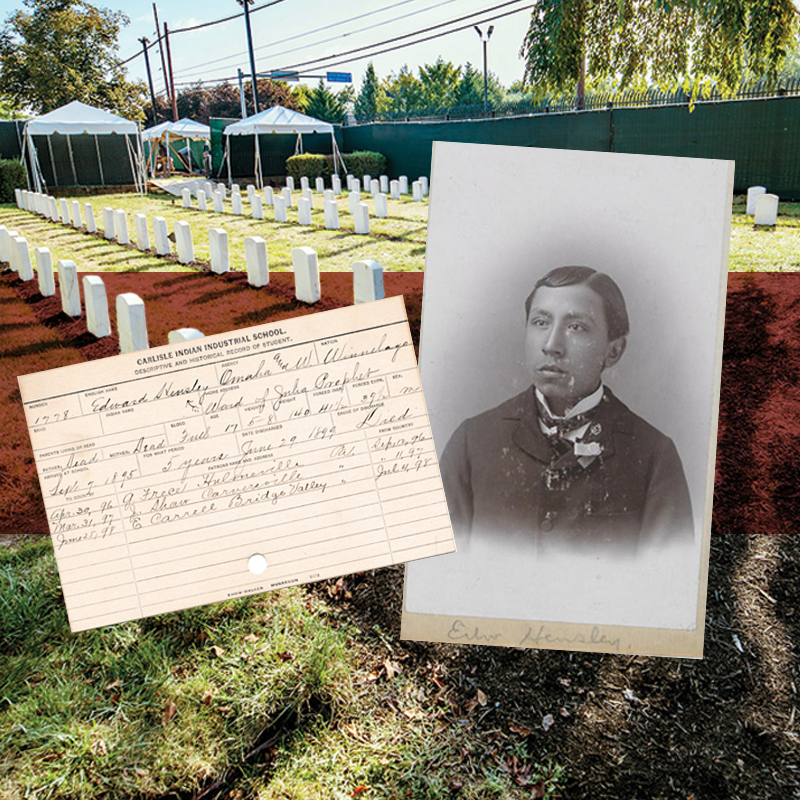
- Details
- By Jenna Kunze
The Winnebago Tribe of Nebraska filed a lawsuit on Wednesday against the United States Army, seeking the return of the remains of two children who died and were buried at the US government’s flagship Indian boarding school more than 120 years ago.
The lawsuit, which was filed in federal court by the Native American Rights Fund (NARF) on behalf of the tribe, alleges that the Army failed to follow federal law and instead deferred to its own process. Listed as defendants in the lawsuit are: The U.S. Army, the Office of Army Cemeteries, and three individual employees who oversee the Office of Army Secretaries, and the cemetery where the children are buried.
At the center of the lawsuit is a disagreement between Winnebago Tribe and the U.S. Army as to whether or not federal law for repatriation applies to the cemetery at the site of the former Carlisle Indian Industrial School. The Carlisle Main Post Cemetery, which is now operated by the Army, is where Winnebago citizens Edward Hensley and Samuel Gilbert—along with roughly 180 other Native American children from tribal nations across the United States— are buried.
Congress enacted Native American Graves Protection and Repatriation Act (NAGPRA) in 1990 to provide a process for federal agencies and museums that receive federal funds to repatriate or transfer certain Native American cultural items—including human remains—back to their respective tribal nations.
NAGPRA sets a clear 90-day timeline for repatriation and provides guidelines for institutions to initiate tribal consultation. It also allows tribes to decide themselves who will claim children who are culturally affiliated to them.
Under the Army’s policy, though, the Army sets its own guidelines, defines who can request the return of a child buried at Carlisle (their “closest living relative”), and lacks a process for following cultural protocols in disinterments, which happen only once a year under the Army’s rules.
Native News Online has previously reported what Indian law experts have said on the matter, including the application of NAGPRA, which they say takes precedence over the Army’s policy.
In October, the Winnebago Tribe sent a formal letter to the defendants requesting that they repatriate the remains of Samuel and Edward from Carlisle Cemetery, pursuant to NAGPRA.
But the Army has maintained that NAGPRA doesn’t apply to the Carlisle Main Post Cemetery “because the remains are not part of a collection,” they wrote in a Federal Register Notice in 2021.
On December 11, 2023, the tribe received a letter from Executive Director of the Office of Army Cemeteries (OAC) Karen Durham Aguilera, a defendant in the lawsuit, denying Winnebago’s request and refusing to repatriate Samuel and Edward pursuant to NAGPRA, according to the lawsuit. “Defendant Durham-Aguilera stated that OAC would only consider ‘disinterring and returning’ Samuel and Edward according to makeshift OAC internal policies and practices,” the lawsuit reads.
A spokesperson from the Office of Army Cemeteries said the Army cannot speak to ongoing litigation, but added that the department is planning to return an additional 30 Native children buried at Carlisle this year.
“The Army remains committed to working with all tribes and families to return their children who died while attending the Carlisle Indian Industrial School and are buried at the Carlisle Barracks Post Cemetery, to their native tribes and lands,” OAC spokesperson Olivia Van Den Heuvel said in a statement to Native News Online.
The larger picture
In 1879, what was then the Army’s Carlisle Barracks became the site of the nation’s first Indian boarding school, which was operated by the Department of the Interior until 1918 in Carlisle, Pennsylvania.
During those 39 years, government officials at the school forcibly assimilated 7,800 Native American children from more than 140 tribal nations through a mix of Western-style education and hard labor. Close to 200 children from 59 different tribes died there, of disease often made worse by poor living conditions and abuse, and were buried at the school.
On September 7, 1895, Captain Beck, an Indian Agent of the Omaha and Winnebago Indian Agency in Nebraska, brough Winnebago tribal citizens Edward Hensley, 17, and Samuel Gilbert, 19, to Carlisle.
Gilbert died 47 days later, according to his student record. There is no cause of death listed.
Hensely died four years later, his school record shows. Both boys were buried on school property, where they’ve remained ever since.
Since 1918, the United States Army War College has controlled the grounds of the former Indian Boarding School, including its cemetery.
The Army began the process of exhuming and returning Native children to their tribal nations in 2017 when Yufna Soldier Wolf of the Northern Arapaho Tribe won her 10-year battle to return three Arapaho children back to their tribal homelands for reburial.
Since then, the Army has used its own policy to return a total of 32 children in six disinterment projects.
Last year, the Sisseton Wahpeton Oyate tribe of South Dakota also asked the Army to follow NAGPRA in the return of their ancestor, who tribal historian Tamara St. John had spent six years researching to fulfill Army protocols in order to bring their child home.
The Army refused to follow NAGPRA, but agreed to include the Sisseton Wahpeton Oyate’s Amos LaFromboise in the 2023 disinterment cycle, which concluded in September.
Instead of further delaying Amos’ repatriation to fight for NAGPRA, the Sisseton Wahpeton Oyate instead drafted a Written Plan of Action, signed by the Director the Army Cemeteries and the participating tribal chairpersons, to outline the plan for disinterment. Additionally, in the Plan of Action, both parties maintained their opposing positions on NAGPRA, stating that they “seek to avoid conflict…and reach a compromise so that the remains of Amos and Edward can be delivered to their tribal homes in a culturally appropriate and expeditious manner.”
St. John told Native News Online that she believes this lawsuit is likely just the beginning of an ongoing push for tribal sovereignty when it comes to enforcing NAGPRA for tribal nations seeking to bring their children home from Carlisle.
“I know other tribes are coming,” she said. “We've all been in communication and working together, and we've all learned from the tribes before us, just like [Sisseton Wahpeton] did from Rosebud. There's a lot of things that happen in history that we can't undo or … there aren't solutions for. This [is] real action.”
Winnebago Tribal Historic Preservation Office Sunshine Bear, who has been researching methods to bring her tribe's children home since 2021, told Native News Online that this lawsuit is about tribal sovereignty, and paving the way for other tribes to bring their children home on their own timeline, and with their own customs.
“I can see why tribes would go the fast route, because they want their children back,” said Thomas-Bear.
Thomas-Bear said that, because Samuel and Edward died at Carlisle, it’s been difficult–if not impossible–for her to find their closest living relatives. But that allows the Winnebago to play the long game in getting their children back by suing the Army, since they’re not rushing to bring home their children to aging elders.
“How can we get the Army to follow the NAGPRA regulations if we continue to bow down and say, ‘We’ll just take them?’ That is not paving the way for other tribes,” Thomas-Bear said. “We want to help lead and make a better way for tribes, and ensure that everyone within this country is following these laws.”
More Stories Like This
50 Years of Self-Determination: How a Landmark Act Empowered Tribal Sovereignty and Transformed Federal-Tribal RelationsSRMT Child Support Enforcement Unit Delivers Holiday Food Boxes to Families
The Shinnecock Nation Fights State of New York Over Signs and Sovereignty
Navajo Nation Council Members Attend 2025 Diné Action Plan Winter Gathering
Ute Tribe Files Federal Lawsuit Challenging Colorado Parks legislation
Help us defend tribal sovereignty.
At Native News Online, our mission is rooted in telling the stories that strengthen sovereignty and uplift Indigenous voices — not just at year’s end, but every single day.
Because of your generosity last year, we were able to keep our reporters on the ground in tribal communities, at national gatherings and in the halls of Congress — covering the issues that matter most to Indian Country: sovereignty, culture, education, health and economic opportunity.
That support sustained us through a tough year in 2025. Now, as we look to the year ahead, we need your help right now to ensure warrior journalism remains strong — reporting that defends tribal sovereignty, amplifies Native truth, and holds power accountable.
 The stakes couldn't be higher. Your support keeps Native voices heard, Native stories told and Native sovereignty defended.
The stakes couldn't be higher. Your support keeps Native voices heard, Native stories told and Native sovereignty defended.
Stand with Warrior Journalism today.
Levi Rickert (Potawatomi), Editor & Publisher


